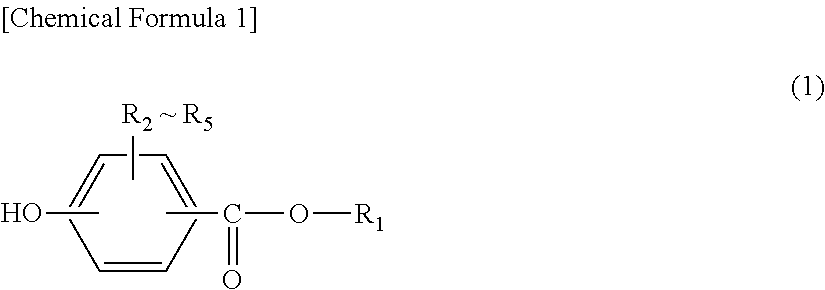Synthetic resin laminated sheet
a synthetic resin and laminate technology, applied in the field of laminated synthetic resin sheets, can solve the problems of whitening or cracking of the surface, black spots, bumps, etc., and achieve the effect of less susceptible to damage, easy softening, and suppressing whitening or crack
- Summary
- Abstract
- Description
- Claims
- Application Information
AI Technical Summary
Benefits of technology
Problems solved by technology
Method used
Image
Examples
production examples
[0208]Hereinafter, production examples of a polycarbonate resin (A) used with the present invention will be described, although the present invention should not be limited to these production examples.
[0209](Synthesis of Terminating Agent)
synthetic example 1
[0210]Based on the Handbook of Organic Chemicals, pp. 143-150, 4-hydroxybenzoic acid from Tokyo Chemical Industry and 1-hexadecanol from Tokyo Chemical Industry were used for esterification through dehydration reaction, thereby obtaining hexadecyl para-hydroxybenzoate (CEPB).
synthetic example 2
[0211]2-Hexyldecyl para-hydroxybenzoate (HDPB) was obtained in the same manner as Production example 1 except that 1-hexadecanol in Synthetic example 1 was changed to 2-hexyldecanol (trade name: NJCOL 160BR) from New Japan Chemical.
PUM
| Property | Measurement | Unit |
|---|---|---|
| glass-transition temperature | aaaaa | aaaaa |
| thickness | aaaaa | aaaaa |
| height | aaaaa | aaaaa |
Abstract
Description
Claims
Application Information
 Login to View More
Login to View More - R&D
- Intellectual Property
- Life Sciences
- Materials
- Tech Scout
- Unparalleled Data Quality
- Higher Quality Content
- 60% Fewer Hallucinations
Browse by: Latest US Patents, China's latest patents, Technical Efficacy Thesaurus, Application Domain, Technology Topic, Popular Technical Reports.
© 2025 PatSnap. All rights reserved.Legal|Privacy policy|Modern Slavery Act Transparency Statement|Sitemap|About US| Contact US: help@patsnap.com



